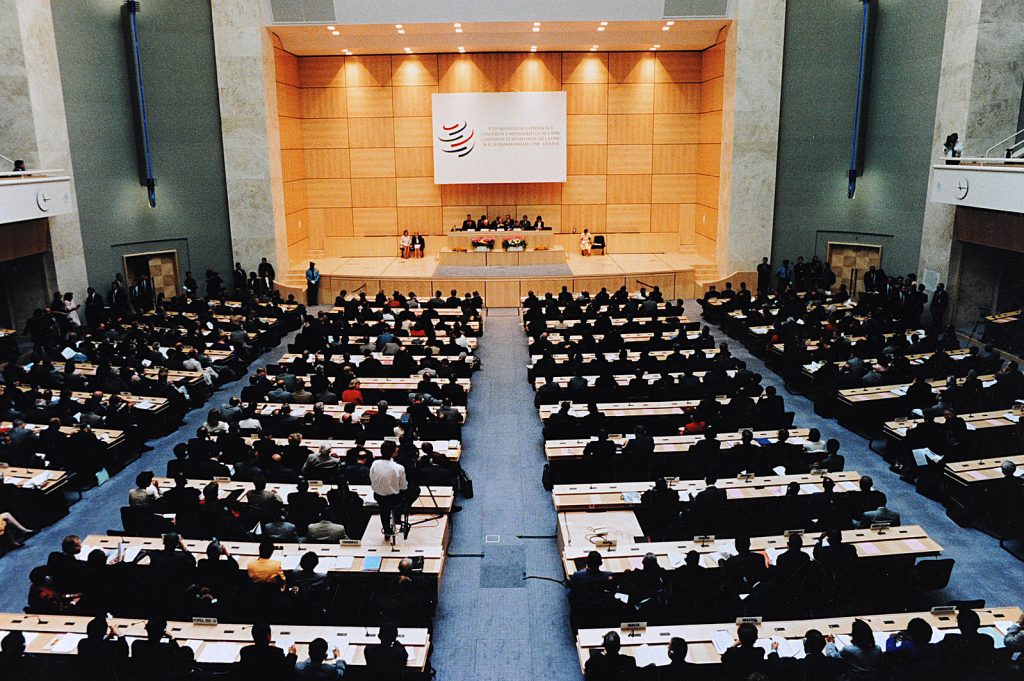The World Trade Organization (WTO) is set to debate lifting its ban on the use of tariffs on digital goods, according to a Bloomberg report.
The conversation about how to tax digital goods is ongoing.
Since the ban was introduced in 1998, the digital economy has been exempt from the duties applied to physical goods, in a way that has facilitated its runaway success. However, with developing countries seeking to raise more income from tariffs on technologies like 3D printing, it’s looking increasingly likely that the moratorium will not be renewed, in an outcome that could disrupt online trade.
“At a time when the spill-over effects of the war in Ukraine are already placing a significant drag on global growth, the last thing we all need is for the WTO’s digital moratorium to lapse,” John Denton, Secretary-General of the International Chamber of Commerce warned in an opinion piece last week. “Absent decisive action in the coming days, trade diplomats may inadvertently ‘break the internet’ as we know it today.”

Digital duties: where does 3D printing come in?
When the WTO first introduced its ban on digital duties, it did so to protect what was then an emerging e-commerce market. The idea being that applying tariffs to the ‘electronic transmission’ of digital goods, such as software, emails or text messages, would prevent the kind of creativity that has since emerged through online commerce over the last two decades.
However, this moratorium isn’t set in stone. Every two years since 1998, governments have agreed to extend the ban at the WTO Ministerial Conference, and with this year’s meeting now underway in Geneva, it’s thought that WTO members could be wavering in their commitment to it, due to the allure of imposing tariffs on a market worth an estimated $26.7 trillion.
India and South Africa, in particular, have lobbied to end the ban and to begin imposing tariffs on cross-border data flows. The logic of the countries’ representatives being that they’ve lost revenue on the digitization of previously physical goods like DVDs and books, thus they now need to recover this via duties.
Ahead of the Ministerial Conference in 2020, when the ban was last renewed, the two nations also published a paper, in which they argued that it disproportionately affected emerging economies. Specifically, the countries made the case that with digital technologies like 3D printing, AI and data analytics becoming more prevalent, preventing tariffs on them would only increase their reliance on the West.
“With zero tariffs, the moratorium is likely to make developing countries even more dependent on imports of digital products,” they argued. “This will have huge negative impacts on industrialization, particularly digital industrialization and trade competitiveness. It will inhibit the ability of developing countries to protect their nascent domestic digital industries resulting in loss of jobs and increasing poverty.”

Could changes ‘break the internet?’
While the exact meaning of ‘electronic transmissions’ isn’t defined in the WTO’s moratorium, it’s now applied to products like video games and streaming sites that didn’t exist when it was first drawn up. As such, if the ban were to be watered down or withdrawn, this may not ‘break the internet,’ but it could leave consumers facing higher bills when they download digital goods developed abroad.
Though the OECD estimated in 2019 that lifting the ban would allow countries to raise $280 million to $8.2 billion in annual customs revenue, it also said this would impact global output and productivity. Likewise, the International Monetary Fund (IMF) has previously warned against the ‘balkanization’ of the digital economy, and calculated that this would reduce worldwide output by 6% over the next decade.
Denton, meanwhile, argues that tariffs are “simply unnecessary” given the taxation opportunities open to governments, but think tanks further afield have also begun to acknowledge how current rules are stacked against emerging economies.
“India, South Africa and their allies use the moratorium as leverage because they can,” explains Hosuk Lee-Makiyama, Director of the European Centre for International Political Economy in Brussels. “Developing countries have everything to win and nothing to lose by holding the WTO prohibition on data tariffs ransom.”

The digital goods trade debate
The WTO’s discussions around e-commerce tariffs tie into a wider, long-running discussion around 3D printing in the context of digital trade. In the past, this has seen the likes of the World Economic Forum wade in with warnings about the dangers of online piracy that come with the technology, ideas that it formalized in a white paper published ahead of the last Ministerial Conference in January 2020.
In its paper titled “3D Printing: A Guide for Decision-Makers,” the group made the case that introducing tariffs would require the tracking of 3D printing design files, something that could be difficult to achieve and “add new levels of friction” to trade. The WEF has since followed this up with a seven-point 3D printing plan to help the technology fulfill its potential, once again placing it at the center of the debate.
With the 3D printing market also growing 19.5% in 2021 alone, that is according to the 2022 Wohlers Report, the technology itself will no doubt continue to be a point of contention in digital trade discussions.
To stay up to date with the latest 3D printing news, don’t forget to subscribe to the 3D Printing Industry newsletter or follow us on Twitter or liking our page on Facebook.
For a deeper dive into additive manufacturing, you can now subscribe to our Youtube channel, featuring discussion, debriefs, and shots of 3D printing in-action.
Are you looking for a job in the additive manufacturing industry? Visit 3D Printing Jobs for a selection of roles in the industry.
Featured image shows the the 1998 Geneva Ministerial Conference, where the WTO’s ban on digital duties was introduced. Photo via the WTO.



